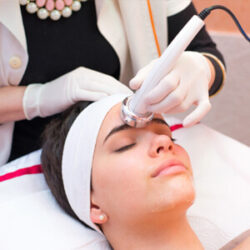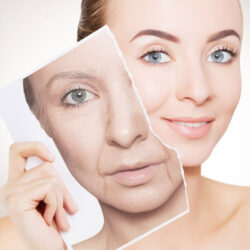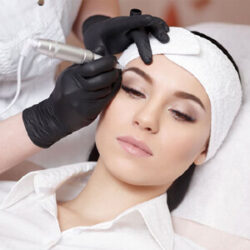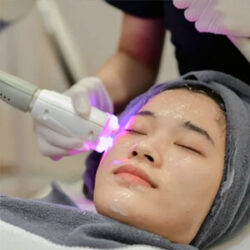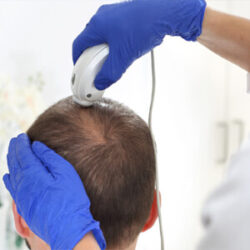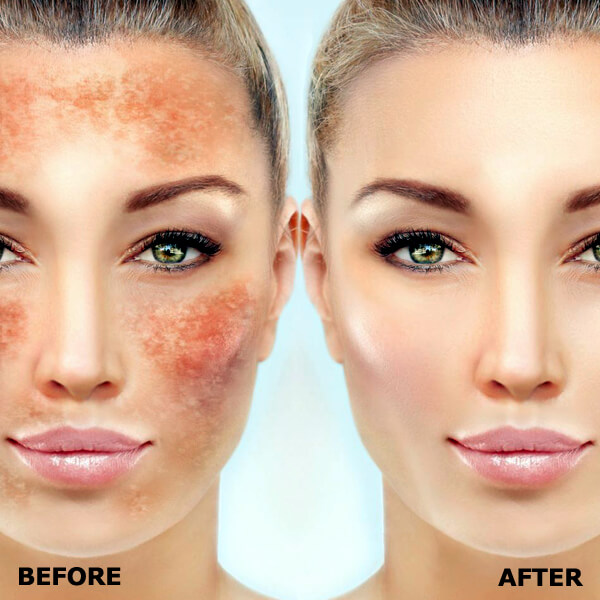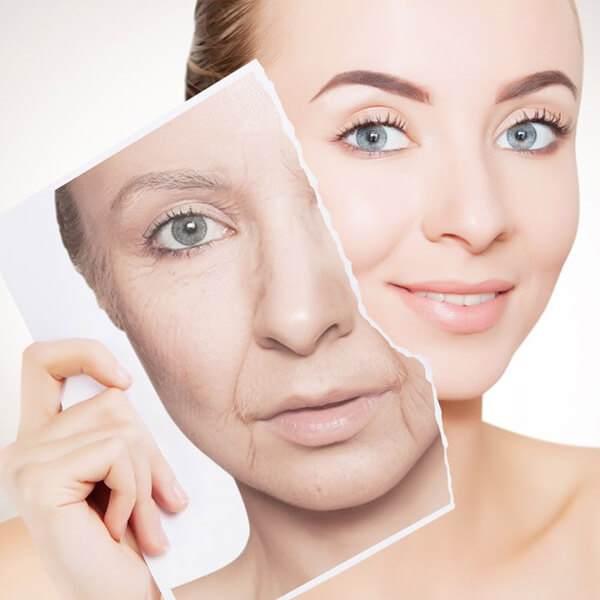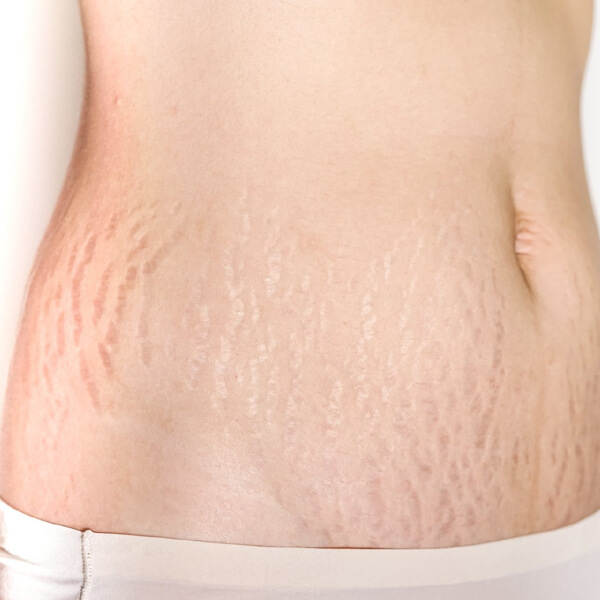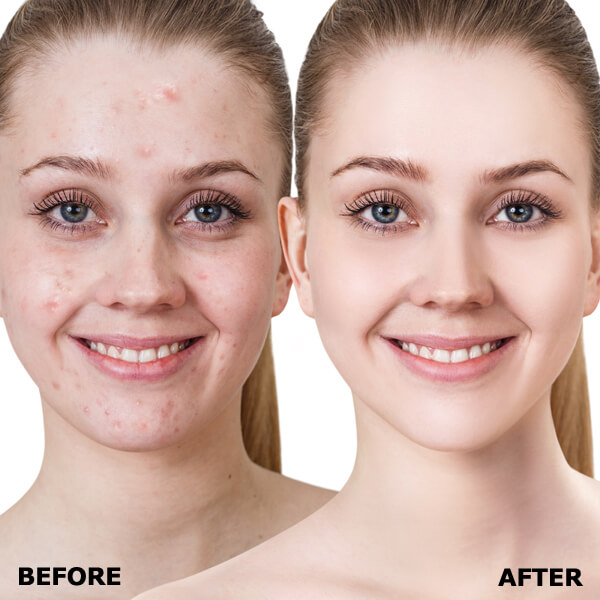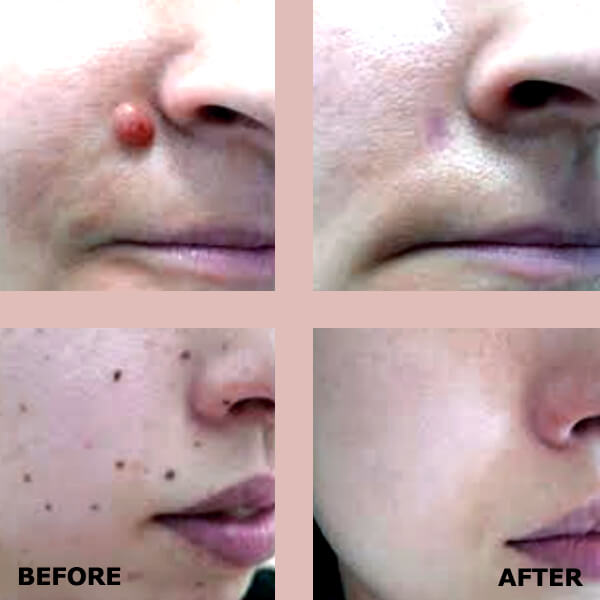1. What are stretch marks and what causes them?
Stretch marks are visible lines that develop when the dermis tears due to rapid stretching, disrupting collagen and elastin fibers. Several factors are responsible for the formation of stretch marks:
- Puberty: Stretch marks may occur on the back, breasts, or abdominal area during the growth spurt of puberty
- Fluctuations in fat or muscle: Obesity and rapid weight loss are among the most common causes of stretch marks. Weightlifters are also prone to developing stretch marks due to muscle gain.
- Pregnancy: Stretch marks frequently develop during the third trimester of pregnancy, likely as a result of the weight gain and hormonal changes associated with pregnancy.
- Medications: Inappropriate use of corticosteroid creams, ointments, or tablets may cause stretch marks.
- Diseases: Some medical disorders, including Cushing’s syndrome, Marfan syndrome, or Ehlers-Danlos syndrome, can predispose an individual to developing stretch marks.
All in all, common causes include: rapid weight changes, pregnancy hormones, puberty growth spurts, genetic predisposition, corticosteroid medications, and certain medical conditions.
2. What Do Stretch Marks Look Like?
Stretch marks are fine lines that run through the skin. There are two types of stretch marks. New stretch marks are called striae rubra. They can be red, pink, or purple depending on your skin tone, and may be slightly raised or itchy.
Old stretch marks are called striae alba. As stretch marks age, they flatten and lighten. Striae alba are white or silvery in colour and may become wrinkled or papery in feel.
3. When Should I See a Dermatologist to Treat My Stretch Marks?
Mature stretch marks are significantly harder to treat than early-stage stretch marks. Treatment should commence as soon as possible to achieve the maximum reduction in colour, length, and width of your stretch marks. Early treatment by a dermatologist can also prevent you from wasting time and money on unproven remedies that do not produce results.
4. How Are Stretch Marks Treated By a Dermatologist?
Although it is difficult to completely eliminate stretch marks, dermatologists offer advanced, non-invasive to minimally invasive procedures that can significantly fade scars and stretch marks, restoring smoother, more even-toned skin.
Common Treatments Include:
- Laser Therapy boosts collagen creation which helps to renew scarred skin while enhancing skin tone.
- RF microneedling treatment intensifies skin texture by promoting collagen and elastin production.
- Chemical Peels work by exfoliating damaged skin which allows new skin layers to surface.
- Regular application of Topical Retinoids & Silicone Gels results in the flattening and lightening of recent scars.
- Platelet-Rich Plasma (PRP) Therapy employs growth factors to speed up the healing process.
At our clinic, our dermatologists often use a combination of the above treatments to give you the best results. Your treatment will vary depending on the unique characteristics of your skin and the extent of your stretch marks.
5. Which treatment is best for Indian skin tones?
The application of RF microneedling and PRP are usually the safest methods for darker tones when considering stretch mark treatment for Indian skin. These treatments provide excellent results while also lowering the chances of hyperpigmentation.
6. Can stretch marks be prevented during pregnancy?
Regular application of a good moisturizer, controlled weight gain, and keeping the body well hydrated are the measures that can help reduce the severity of the stretch marks, but these measures may not prevent the marks completely. Genes contribute immensely to the development of stretch marks in pregnancy.
7. Is the treatment painful?
Most patients report that the pain is mild and feels like a snap from a rubber band. Topical numbing cream can be applied. Our state-of-the-art equipment has cooling mechanisms that ensure the patient’s comfort during the procedure.
8. Will there be scars from the treatment?
Professional stretch marks treatment in Patna at our clinic with all the proper protocols does not result in scarring. The temporary marks from treatment fade completely after a few days to weeks.
9. What are the risks, safety, and contraindications of the treatment?
Some of the common side effects that appear are temporary redness, mild swelling, and light peeling of the skin which subside within a few days. If a woman is pregnant, has an active infection, or a specific medical condition, then this treatment is not suitable. Our careful screening before the procedure will make sure that you are eligible for the treatment.
10. Can scars and stretch marks be completely removed?
While no treatment can fully erase them, advanced procedures can significantly reduce their visibility, making them much less noticeable.
11.How to Prevent New Stretch Marks?
Keep your weight stable, use vitamin E-enriched moisturisers on a daily basis, do not forget the importance of hydration, and add foods to your diet that boost collagen production. Regular skincare with retinoids (only when advised by the dermatologist) can strengthen skin’s elasticity against future stretching.
12. What happens if treatment is delayed?
If treatment is delayed, the marks will usually become mature white scars that require more intense procedures and multiple sessions to be treated. The early-stage red marks that are easy to treat gradually become resistant white marks that need to be treated with aggressive methods.
13. How many sessions are needed?
- Scars: 3–6 sessions (spaced 4–6 weeks apart).
- Stretch Marks: 4–8 sessions, depending on severity.
14. When will I see full results?
The initial improvements are visible in 2-3 weeks; however, the best stretch mark before/after results are usually noticeable at 3-6 months. The collagen remodeling continues long after treatment, giving the skin a better look.
15. What are the benefits of getting stretch mark treatment?
Stretch mark removal treatment in Patna not only revitalizes the smooth texture of the skin and the even tone of the skin but also enhances self-confidence. The stretch mark treatment downtime is very short, thus allowing you to be back to your routine very soon with the results continuing to improve in the following days.
Treatment Options We Offer in Patna
Laser Therapy
- How it works: Fractional CO₂ laser stretch marks treatment stimulates deep collagen production by creating micro-injuries in the skin.
- Sessions needed: 4-6 sessions, spaced 4-6 weeks apart
- Recovery/Downtime: 5-7 days mild redness and peeling
- Best suited for: All skin types, especially mature white stretch marks
- Pros & Cons: Highly effective with long-lasting results; requires downtime and sun protection post-treatment
RF Microneedling Treatment
- How it works: Combines radiofrequency energy with tiny needles to remodel collagen and elastin fibers
- Sessions needed: 3-5 sessions monthly
- Recovery/Downtime: 2-3 days minimal swelling
- Best suited for: Microneedling for stretch marks in Patna works best on textured marks
- Pros & Cons: Minimal downtime with excellent skin tightening; multiple sessions required for optimal results
Chemical Peels
- How it works: Chemical peel for stretch mark treatment uses acids to exfoliate damaged skin layers.
- Sessions needed: 6-8 sessions biweekly
- Recovery/Downtime: 3-4 days mild peeling
- Best suited for: Superficial marks on lighter skin tones
- Pros & Cons: Affordable and improves skin texture; limited effectiveness on deep marks
Platelet-Rich Plasma (PRP) Therapy
- How it works: Uses your own blood’s growth factors to stimulate natural healing and collagen production
- Sessions needed: 3-4 sessions monthly
- Recovery/Downtime: No downtime, immediate return to activities
- Best suited for: Early red stretch marks and sensitive skin
- Pros & Cons: Natural treatment with no allergic reactions; requires multiple sessions for visible results
GFC Therapy
- How it works: Growth Factor Concentrate therapy delivers concentrated healing factors directly to damaged skin
- Sessions needed: 3-4 sessions at 3-week intervals
- Recovery/Downtime: Zero downtime
- Best suited for: All stages of stretch marks, especially pregnancy-related
- Pros & Cons: Superior to PRP with faster results; premium treatment option with higher cost
Combination Therapy
- How it works: Combines multiple modalities like laser with PRP for enhanced results
- Sessions needed: Customized based on severity
- Recovery/Downtime: Varies by treatments combined
- Best suited for: Severe or resistant stretch marks
- Pros & Cons: Most effective approach for stubborn marks; requires commitment to multiple treatment types
Topical Treatments
- How it works: Regular application of Topical Retinoids & Silicone Gels stimulates surface-level collagen renewal
- Sessions needed: Daily application for 3-6 months
- Recovery/Downtime: None
- Best suited for: Early prevention and mild marks
- Pros & Cons: Easy home treatment with no downtime; slower results requiring patience and consistency
What Types/Stages of Stretch Marks We Treat?
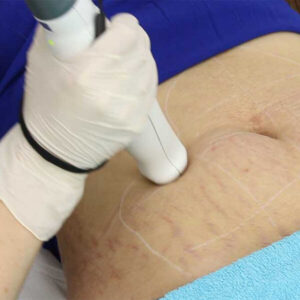
Our stretch marks treatment clinic provides solutions for every stage of stretch marks. The early stage of stretch marks, called striae rubra, appears as red or purple marks and are raised because of active inflammation and collagen breaking down. The treatment of PRP and laser therapy produces excellent results for these specific marks.
On the other hand, the mature stage of stretch marks, known as striae alba, presents as white or silvery marks which appear flat or depressed below the skin surface. The treatment of mature stretch marks requires aggressive methods including fractional CO₂ laser stretch marks treatment or RF microneedling.
The stage of your stretch marks helps determine which would be the best way to treat stretch marks at our Patna clinic that will produce the best results in the long run.
Before-During-After Treatment Flow / What to Expect
1. Consultation: Detailed skin analysis and customized treatment planning. The expert evaluation will identify the most effective treatment method for your particular stretch marks.
2. Treatment Plan: A personalized treatment plan will be created with an estimation of treatment timeline and expected results. The treatment plan includes a clear schedule which outlines both the number of sessions and their corresponding intervals.
3. During Session: The procedure takes place in a comfortable environment where topical numbing agents are used when needed. The duration of each treatment session ranges between 30 to 45 minutes for each treated area.
4. Immediately After: Patients may experience typical post-treatment effects which include mild redness and swelling. Cooling packs can be applied to the treated areas to reduce discomfort.
5. Recovery Timeline: Patients can typically return to their regular activities within 24 to 48 hours after treatment. The duration of complete healing depends on the treatment method used and can range from 3 to 7 days.
Aftercare & Maintenance
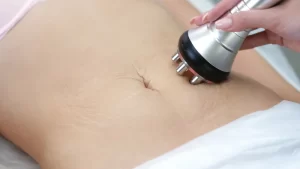
Your stretch mark removal treatment in Patna will deliver the best results when you follow certain post-treatment care instructions. The following essential steps will produce the best possible results from your treatment:
- Avoid direct sunlight for 2 weeks after treatment while using prescribed moisturizers twice daily
- Avoid using harsh exfoliants and scrubs during the first week after treatment
- Drink at least 8-10 glasses of water each day to stay hydrated
- Use only fragrance-free gentle skincare products in your skin care routine
Regular maintenance sessions performed every 3-6 months will help you maintain your achieved results. Our team will give you individualized aftercare directions for lasting improvement.
Why Early Treatment Matters?
The success rate of stretch mark treatments is much higher when patients seek treatment during the initial stages of mark development. The skin maintains its healing potential when marks still appear as red or purple which enables better treatment responses.
Early intervention with a customized stretch mark treatment plan prevents the formation of deep white scars that need more intensive procedures. Also, the cost of stretch mark treatment in Patna is also lower when addressed early because it requires fewer sessions while producing excellent results. Don’t delay—treating fresh marks within the first year yields the best results.
Why Choose Us in Patna?
1. Expert Dermatologist: Dr. Rizwana Barkat (MBBS, MD Skin & V.D) provides specialized dermatological expertise to treat different types of stretch marks, including complex cases.
2. Advanced Technology: The clinic is equipped with state-of-the-art and FDA-approved laser technology and equipment to deliver exceptional results.
3. Proven Safety Protocols: The clinic follows strict safety protocols which include complete sterilization and strict adherence to safety guidelines.
4. Comfortable Ambience: The clinic provides a comfortable environment for all patients through its modern and hygienic facilities.
5. Customized Approach: The clinic provides individualized stretch mark treatments after pregnancy and patients with different skin types.
6. Track Record: We are the best dermatology clinic in Patna backed by hundreds of successful treatments under the care of Dr. Rizwana Barkat (MBBS, MD Skin & V.D). We employ the most modern laser and globally advanced technology to treat patients safely.

Looking for the Best Stretch Marks Removal Treatment in Patna?
Visit R Square, Skin, Hair, Nail Clinic for expert consultation with our consultant dermatologist, Dr. Rizwana Barkat. Our stretch mark removal clinic is backed by modern technology and specialized expertise of experienced skin specialists with proven results. We offer comprehensive solutions including stretch mark laser treatment in Patna along with other diverse treatment approaches customized on a case-by-case basis. Schedule your appointment today!

